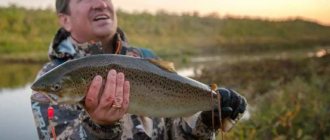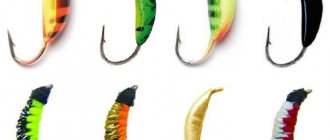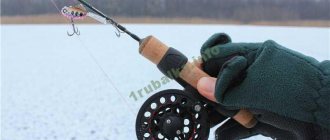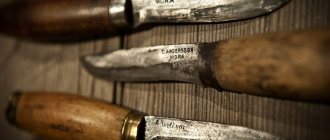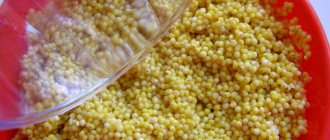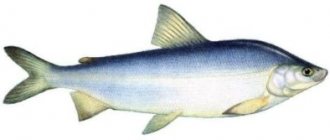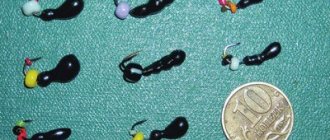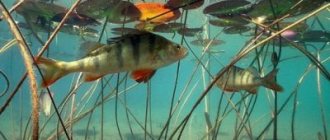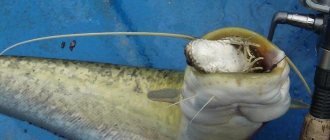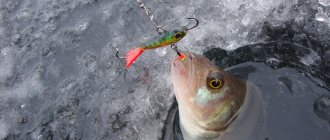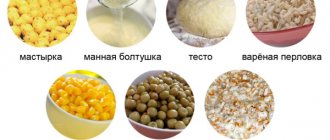Fishing in the Murmansk region
Fishing in the Murmansk region is not only a good catch, but also a completely special world with diverse landscapes, incredible colors and amazing nature.
On the Kola Peninsula (the main territory of the Murmansk region) there are about two tens of thousands of rivers and streams belonging to the basins of the Barents, Baltic and White seas. There are even more lakes in the region. The largest are Imandra, Umbozero and Lovozero.
Most local reservoirs are rich in valuable species of fish - salmon, trout, char, nelma, whitefish and grayling are found here.
Fishing on the Barents Sea
Fishing in the northern latitudes on the Kola Peninsula attracts many people not only with the possibility of a rich catch, but also with the desire to see the beautiful and harsh terrain.
What attracts fishing in Murmansk
697 456 What attracts fishing in Murmansk What attracts fishing on the Kola Peninsula in Murmansk in the Barents Sea with exit from Teriberka
The most beautiful places on the coast of the Barents Sea attract the eye and allow you to meditate for hours looking at the moss-covered hills and steep cliffs. If the main goal of traveling to one of the cleanest bodies of water in Europe is to catch trophy cod, flounder or sea bass, then before you set off you need to learn about the peculiarities of fishing in the Murmansk region.
Fishing on the Kola Peninsula
The main asset of the peninsula is the rivers in which salmon spawn. Therefore, fishing on the Kola Peninsula attracts both experienced fishermen who dream of catching trophy salmon, and lovers of active recreation.
The best catch on the Kola Peninsula is salmon. It is caught in most reservoirs. But she is not the only one who can be caught.
Numerous reservoirs are inhabited by a huge number of fish: brown trout, grayling, burbot, pink salmon, whitefish, ide, pike, perch, roach, trout.
Fishing in Murmansk and the region is carried out in two main ways - fly fishing and spinning.
Northern coast of the peninsula
All rivers of the Barents Sea basin belong to the northern coast of the Kola Peninsula. The upper reaches lie in a fairly flat and marshy area.
The lower reaches of the rivers of the Barents Sea basin have a significant slope and, accordingly, good flow with numerous rapids and rifts. In some of them, the river passes through fairly high rocky areas, forming powerful waterfalls.
The salmon herd in these rivers is not so numerous in comparison with the southern and southeastern Terek coast of the peninsula, but the average size of individuals is incomparably larger.
You can get to the fishing camps on the northern coast by helicopter or by sea from Murmansk.
The best time for fishing begins in June and lasts until about mid-July.
Source
Fishing Features
Fish enter the rivers and lakes of the Kola Peninsula to spawn from the sea, where they mainly live. Therefore, the most exciting thing for fishermen is sea fishing in Murmansk.
All avid fishermen love sea cod fishing in the Barents Sea. Thanks to the warm waters of the Gulf Stream throughout the year in Murmansk, as in Norway, sea fishing does not stop even in winter. During such fishing, you can successfully catch cod weighing even up to 30 kg. The best cod fishing in the Barents Sea occurs between March and May.
Fishing in Murmansk provides the opportunity to raise other types of fish:
- halibut and catfish
- sea bass and flounder
- burbot, pollock, haddock and a number of other fish
Exciting sea fishing in Murmansk with very reasonable prices, especially in comparison with Norway, will pleasantly surprise you with a rich catch. But for successful fishing, you need to take care in advance about purchasing suitable and reliable gear. With our experienced specialists, this task can always be easily resolved. Pleasure and luck are guaranteed!
11:00 – visit to the Sami ethno-village
with entry into the largest tent in Russia, acquaintance with the history of the Sami people, Sami games, feeding reindeer, communicating with huskies.
For this tour you can receive cashback from the state up to 20%. Details are available from our managers.
Type of tour : mini-group from 2 to 6 people.
Tour dates in 2021 : any.
Tour duration : 5 days / 4 nights
Tour cost per person:
| Number of people in the group | Price |
| 6 people | from 62330 rub. |
| 5 people | from 66,700 rub. |
| 3-4 people | from 72970 rub. |
| 2 people | from 88205 rub. |
Included in cost:
- transfer Murmansk airport – hotel – airport;
- meeting at the airport;
- breakfasts, dinners at the hotel;
- lunch boxes for fishing;
- fishing on the sea, lake, river, escort;
- fishing equipment;
- transfers according to the program;
- visit to the Sami ethno-village;
- barbecue cooking master class;
- catch-and-seizure licenses for river fishing;
- fly fishing master class;
- preparing the catch for transportation.
Additional charges:
- air travel;
- suits - waders for fly fishing;
- shaman show;
- alcohol.
Tour program
Day 1
9:30 — Arrival in Murmansk
morning flight.
10:30 – meeting at the airport, transfer to the hotel.
Arrival at the hotel, check-in. Eco Home Hotel located next to the picturesque
- a real chateau hotel in the Russian North, offering you a secluded holiday in the forest with comfort. The complex has five cottages, each with four rooms (three doubles and one triple), making it convenient for companies, families, and independent travelers. Rest and peace are guaranteed.
12:00 – lunch. In the hotel restaurant, gourmets will find new, vibrant experiences from Arctic cuisine. The chef will pamper you with a crab show, signature healthy lifestyle dishes, traditional treats from venison, elk, and freshly caught sea and river fish. All dishes are prepared from local, organic products.
16:00 – selection of equipment for sea fishing.
What kind of fish is caught:
- cod,
- halibut,
- whitefish,
- brown trout,
- scallops,
- sea urchin.
Day 2
7:30 – early “Arctic” breakfast at the hotel.
8:00 – transfer to Teriberka
(140 km).
Photo stops on the way to Teriberka. Travel excursion. Lunch boxes to go.
11:00 – safety briefing.
Getting equipment: fishing rods/cords. Fishing. Cod and halibut are caught (recovery of fresh seafood - scallops, sea urchin - additionally, with the help of a diver).
15:00 – hot lunch on the ship.
17:00 – transfer to the hotel.
19:00 – dinner at the hotel (dishes with freshly caught cod).
After an active day, relax in the SPA complex.
Day 3
8:00 – breakfast at the hotel.
9:00 – transfer to Lake Imandra
. A road trip on the road to Imandra, the largest lake on the Kola Peninsula. There are whitefish and brown trout.
Tips for fisherman: Sea fishing from the shore on the Black Sea - Choosing the best
11:00 – visit to the Sami ethno-village
with entry into the largest tent in Russia, acquaintance with the history of the Sami people, Sami games, feeding reindeer, communicating with huskies.
13:00 – fishing on boats on Lake Imandra.
17:00 – transfer to the hotel.
19:00 – dinner at the hotel with a master class on barbecue cooking.
Our Guest Houses are also a suitable place for family and group recreation, celebrations and corporate events of various sizes.
The best recreation and fishing on the Kola Peninsula
If you want to enjoy unforgettable northern nature and good fishing, then we invite you to the coast of the Barents Sea.
Sea fishing in Ura-Guba is always one of the best - it is simply impossible to remain without a catch!
Our Guest Houses are also a suitable place for family and group recreation, celebrations and corporate events of various sizes.
Fishing services:
- Sea fishing in the open Barents Sea on prepared boats with professional guides and captains.
- Fishing for cod, halibut, haddock, pollock, catfish, sea bass.
- And besides sea fishing, the Ura River flows next to us, which will delight you with delicious wild salmon (fishing under licenses).
- The Kola Peninsula is the only place in the world where the population of wild Atlantic salmon (salmon) still exists in sufficient numbers.
- Our boats can accommodate up to 8 and 10 people.
We offer:
→ a comfortable boat with a length of 13.5 meters and a capacity of up to 10 people, rent - 40,000 rubles / day ; → a comfortable boat 12 meters long, designed for up to 8 people, rent - 36,000 rubles/day .
The boats are suitable for both fishing and diving.
What kind of fish are there?
Freshwater reservoirs of the Murmansk region are inhabited mainly by cold-loving fish, whose spawning often takes place in autumn and winter. Only a small part of the inhabitants of the local reservoirs come to spawn in the spring. In rivers and lakes you can catch:
- pike;
- perch;
- whitefish;
- vendace;
- burbot;
- grayling;
- trout;
- smelt;
- smelt;
- lake char;
- palyu.
In addition, there are migratory fish species whose life cycles can take place in both fresh and salt water. These representatives of the ichthyofauna include:
- salmon;
- brown trout;
- loach;
- pink salmon.
These fish enter rivers only during spawning, and spend the main part of their life in the sea. They are of the greatest value and are the main objects of recreational fishing.
The rivers of the Murmansk region abound with large rapids, below which a variety of fish like to stay. In Murmansk and its surroundings you can successfully catch not only freshwater, but also sea fish. The local salty waters are inhabited by:
- cod;
- pollock;
- flounder;
- catfish;
- haddock;
- sea bass;
- capelin;
- herring.
Interesting! Capelin and herring can radically change their habitat and often leave the sea bays located near Murmansk. Other species that lead a predominantly bottom lifestyle are not prone to long migrations and are found here throughout the year.
Sea fishing within the city
Most Murmansk fishermen prefer to fish in the Kola Bay of the Barents Sea, located within the city. On the most favorable days, the weight of the catch can be more than 30 kg. Fishing in the bay does not require the purchase of a paid license, which makes fishing accessible to all segments of the population. A fisherman who comes here for the first time should know that there are certain size restrictions for each type of fish. For example, the length of the caught pollock must be at least 40 cm. Otherwise, the trophy will have to be released. Fishing on the bay is possible both from the shore and from a boat. When fishing on shore, fishermen's trophies often include:
- herring;
- capelin;
- haddock;
- flounder.
Herring and capelin show increased activity in August. They can be caught using light spinning tackle. Small oscillating jig-type spinners and silicone vibrating tails about 4 cm long are used as bait. Wiring should be carried out in the upper and middle layers of the water. Haddock and flounder are caught from the shore using bottom tackle, which should include a fairly powerful rod with a test weight of up to 120 g and a 4000 series spinning reel. A monofilament or fluorocarbon line with a diameter of 0.35 mm is wound onto the spinning spool.
Many fishermen come to the Kola Peninsula to catch large cod in the Barents Sea. Sea bottom rigging consists of a heavy sinker, above which several leashes with hooks are tied. The diameter of the driving monofilament is usually about 0.25 mm. The size of the hook can range from 10 to 4 numbers (according to the international classification) and largely depends on the type of bait used. The bait is:
- sea worm;
- fresh shrimp;
- small vibrating tails made of “edible” rubber.
Sea worms can be found in the bottom soil during low tide. It is easier to purchase fresh shrimp at local fish stores. Excellent places for fishing with bottom gear are located near the village of Lavna. This area is characterized by numerous piers, fishing from which can be more effective than from the shore. On a note! Sea bass, cod and pollock are biting well in the early autumn months. These types of fish stay at a considerable distance from the shore, so to catch them the fisherman will have to use a watercraft. Local residents fish from both small rubber boats and large boats. On the Kola Bay there is constant movement of large sea vessels, so it is not recommended to move more than 200 m from the shore. The largest representatives of the cod species are found in the open sea, however, even in the bay there is a chance of catching a specimen weighing more than 8 kg. For such fishing, a powerful spinning rod equipped with a multiplier reel is used. A braided cord with a breaking load of at least 20 kg is wound onto the “multa” spool. A shock leader made of fluorocarbon fishing line with a diameter of 0.45 mm is attached to the “braided line”, to the end of which a heavy jig class spinner weighing 100–200 g is attached. Above the main bait, hooks with silicone baits attached to them are attached on short leashes. Fishing is carried out exclusively in the bottom layers of water. The fisherman should remember that contact with salty sea water negatively affects all elements of the gear. After fishing, the rod, reel and monofilament should be thoroughly rinsed under fresh running water.
Source
How not to make a mistake when choosing gear for sea fishing
When going out to sea, experienced fishermen always collect gear that is best suited for this type of fishing.
Components of gear for sea fishing:
- High quality spinning rod 2.4 meters long. The rod test should not exceed 500 grams;
- Braided cord;
- A multiplier reel with a line capacity (diameter 0.8 mm) of more than 200 meters and a large number of bearings (the more, the better);
- Equipment (consists of hooks and a pundah with a tee).
Fishing in the open sea is carried out through jigging. To do this, you should immerse the tackle to a depth of 1.5–2 m above the bottom and make rather sharp, confident, rhythmic swings of the rod. During the game, it is recommended to alternate the speed and depth of the tackle to increase the likelihood of a bite.
Cod fishing is just beginning, but there is already something to remember! All the most interesting things are yet to come!
Cod 2021. Opening of fishing in the Barents Sea! What a break! Three fish at a time. Kildin Island.
End of March. Kola Peninsula. Barencevo sea. Cod move! All of Russia is waiting for this fishing...
It finally happened! Snow, rain, wind, cold, fun! They followed her to the East of Kildin. Three fish at a time!
Cod fishing is just beginning, but there is already something to remember! All the most interesting things are yet to come!
We will definitely find some huge trophies! NHNCH.
Fishing 51. Sea fishing on the Kola Peninsula. Sea fishing in the Barents Sea. Cod fishing in the Barents Sea. Trophy. #fishing #seafishing #fishing #Barents Sea #trophy #codfishing #seafishing #fishing51 #cod
And the road runs forward and by evening we are already enjoying the departing rays on the shores of the Arctic Ocean. Kolsky embraced us with good weather and I just enjoyed the moment: the whole journey is ahead and my soul is singing!
10. WHAT FISH WE CAN CATCH: cod, haddock, pollock, halibut, whiting, sea bass. The average weight of fish is from 1 to 10 kg. You also often come across specimens from 10 to 20 kg.
To make all our guests feel comfortable while fishing and relaxing, we post some explanations about the rules of staying with us.
1. ARRIVAL: upon arrival, guests meet and communicate with a representative of the host party, discuss the start time of fishing, and pay for services. In the morning, 30 minutes before the start of fishing, you leave the base using your own transport (or the host party’s transport for an additional fee), the travel time to the pier is about 15 minutes.
2. FOOD: guests arrange for themselves; food can be purchased in Murmansk before arriving at the base, or in stores in the village of Ura-Guba. It is also possible to stay in guest houses without access to the sea with a visit to a wonderful bath-sauna (see the section “Additional services”). Based on experience, when booking a tour with accommodation, we ask guests to take into account our unpredictable northern weather and book not just one trip to the sea, but several, because... not all of them can take place.
4. GEAR: ships are equipped with fishing gear. They are issued free of charge and are included in the price of the tour. When receiving the gear, you give the captain a deposit of 5,000 rubles. He returns at the end of the fishing day. In the event of a break in the tackle, a breakdown of the reel or spinning rod, you need to pay the captain on the spot at the following “rates”
6. BAD WEATHER, STORM: before coming to us, we call you by phone and check the weather conditions 1-2 days in advance. If stormy weather is expected (wind over 10 m/s), we suggest rescheduling the fishing date. In this case, the prepayment is returned. If the weather is CORRECT (from 8 to 12 m/s), we will discuss going out to sea with you over the phone, leaving the decision to arrive at your discretion. Please note that if you arrive and unmoor from the pier in bad weather, money for going out to sea will not be refunded.
8. HOW TO GET TO THE BERTH: enter the village of Ura-Guba, after about 1 km at the intersection, near the bus stop you need to turn right, drive 3 km straight along the dirt road to the parking lot in front of the barrier. That's it - you are there. The pier is equipped with parking for any type of car.
Tips for fisherman: Rod for sea fishing from the shore - What to choose for fishing
9. WHAT TO TAKE WITH YOU: - documents; - clothes for the season; - fishing tackle, fishing rod or spinning rod. If you don’t have personal gear, it doesn’t matter, for the duration of the tour we will provide you with gear or sea spinning rod for FREE; — a knife for processing fish, containers or bags for fish; — a camera or video camera; — disposable tableware for meals on board; - medications recommended by a doctor, the problem of motion sickness can be easily solved by taking the drug "Dramina"; — mosquito and midge repellents (in spring and summer); - personal hygiene items.
10. WHAT FISH WE CAN CATCH: cod, haddock, pollock, halibut, whiting, sea bass. The average weight of fish is from 1 to 10 kg. You also often come across specimens from 10 to 20 kg.
11. DO YOU HAVE ANY QUESTIONS? We will be happy to answer - go to the “CONTACTS”
July 1 2 3 4 5 6 7 8 9 10 11 12 13 14 15 16 17 18 19 20 21 22 23 24 25 26 27 28 29 30 31
Available dates for accommodation in house No. 1
numbers highlighted in red 123 - busy
April 1 2 3 4 5 6 7 8 9 10 11 12 13 14 15 16 17 18 19 20 21 22 23 24 25 16 27 28 29 30
May 1 2 3 4 5 6 7 8 9 10 11 12 13 14 15 16 17 18 19 20 21 22 23 24 25 26 27 28 29 30 31
June 1 2 3 4 5 6 7 8 9 10 11 12 13 14 15 16 17 18 19 20 21 22 23 24 25 26 27 28 29 30
July 1 2 3 4 5 6 7 8 9 10 11 12 13 14 15 16 17 18 19 20 21 22 23 24 25 26 27 28 29 30 31
August 1 2 3 4 5 6 7 8 9 10 11 12 13 14 15 16 17 18 19 20 21 22 23 24 25 26 27 28 29 30 31
September 1 2 3 4 5 6 7 8 9 10 11 12 13 14 15 16 17 18 19 20 21 22 23 24 25 26 27 28 29 30
October 1 2 3 4 5 6 7 8 9 10 11 12 13 14 15 16 17 18 19 20 21 22 23 24 25 26 27 28 29 30 31
Available dates for accommodation in house No. 2
numbers highlighted in red 123 - busy
April 1 2 3 4 5 6 7 8 9 10 11 12 13 14 15 16 17 18 19 20 21 22 23 24 25 26 27 28 29 30
May 1 2 3 4 5 6 7 8 9 10 11 12 13 14 15 16 17 18 19 20 21 22 23 24 25 26 27 28 29 30 31
June 1 2 3 4 5 6 7 8 9 10 11 12 13 14 15 16 17 18 19 20 21 22 23 24 25 26 27 28 29 30
July 1 2 3 4 5 6 7 8 9 10 11 12 13 14 15 16 17 18 19 20 21 22 23 24 25 26 27 28 29 30 31
August 1 2 3 4 5 6 7 8 9 10 11 12 13 14 15 16 17 18 19 20 21 22 23 24 25 26 27 28 29 30 31
September 1 2 3 4 5 6 7 8 9 10 11 12 13 14 15 16 17 18 19 20 21 22 23 24 25 26 27 28 29 30
October 1 2 3 4 5 6 7 8 9 10 11 12 13 14 15 16 17 18 19 20 21 22 23 24 25 26 27 28 29 30 31
Available dates for accommodation in house No. 3
numbers highlighted in red 123 - busy
April 1 2 3 4 5 6 7 8 9 10 11 12 13 14 15 16 17 18 19 20 21 22 23 24 25 26 27 28 29 30
May 1 2 3 4 5 6 7 8 9 10 11 12 13 14 15 16 17 18 19 20 21 22 23 24 25 26 27 28 29 30 31
June 1 2 3 4 5 6 7 8 9 10 11 12 13 14 15 16 17 18 19 20 21 22 23 24 25 26 27 28 29 30
July 1 2 3 4 5 6 7 8 9 10 11 12 13 14 15 16 17 18 19 20 21 22 23 24 25 26 27 28 29 30 31
August 1 2 3 4 5 6 7 8 9 10 11 12 13 14 15 16 17 18 19 20 21 22 23 24 25 26 27 28 29 30 31
September 1 2 3 4 5 6 7 8 9 10 11 12 13 14 15 16 17 18 19 20 21 22 23 24 25 26 27 28 29 30
October 1 2 3 4 5 6 7 8 9 10 11 12 13 14 15 16 17 18 19 20 21 22 23 24 25 26 27 28 29 30 31
The most practical (mobile) boats are PVC boats with a length of more than 4 meters. It’s better to have a boat 5 meters long. This determines its ability to fight sea waves. The heart of the boat, the motor, must become your faithful and reliable companion in order to be able to return even if the sea suddenly begins to be very rough.
All about fishing in Murmansk and the Murmansk region
- Peculiarities
- What kind of fish can you catch?
- Review of fishing spots
- Free Within the city of Murmansk
- Lakes
- Reservoirs
- Rivers
- Paid
The Murmansk region is distinguished by a large number of fresh lakes and reservoirs, many clean and picturesque rivers. Fans of sea fishing can relax on the coast of the northern seas. Beautiful nature and picturesque landscape will be a pleasant addition to fishing organized at any time of the year. On the Kola Peninsula you can go fishing in completely wild places, or organize a civilized vacation with fishing at recreation centers and fishing tours.
Fishing goods in Murmansk - 30 places
In the heading “Goods for fishing, Murmansk” there were 30 places with information - opening hours, indexes, official websites, reviews, telephone numbers and addresses in Murmansk.
1 review 4.0
Goods for fishing
trade
- Murmansk, heroes of Severomorsk 33a, 33a
- 8952-299-1016
- Goods for fishing
1.0
Armory House
- Murmansk, Chelyuskintsev street, 37
- Working clothes, Personal protective equipment, Fishing goods
Rybaklev
Rybaklev, shop
- Murmansk, Kominterna, 22, 1st floor
- 8-800-250-81-51
- Nearest stop – Swimming pool – 949m
- Goods for fishing
Hunting
Equipment Center
- Murmansk, Polyarnye Zori, 19
- Nearest stop — Knipovicha Street — 131m
- Equipment for tourism and recreation, Fishing goods
OkhotActiv
OkhotAktiv, store of goods for hunting, fishing and tourism
- Murmansk, Lenina prospect, 70, ground floor
- Nearest stop — Academician Knipovicha Street — 577m
- Equipment for tourism and recreation, Fishing goods
Hunter
Okhotnik, LLC, store of goods for hunting and fishing
- Murmansk, Karla Marksa, 30, 1st floor
- Nearest stop - Public transport - 908m
- Fishing goods, Hunting goods
Pelican
Pelican, chain store
- Murmansk, Kirova prospect, 62, 1st floor
- Nearest stop – Lenina Avenue – 356m
- Fishing supplies, Aquariums
Cool place
Cool place, fishing goods store
- Murmansk, Krupskoy, 21, 1st floor
- Equipment for tourism and recreation, Fishing goods
Fishing paradise
Fishing paradise, shop
- Murmansk, Leningradskaya, 24, ground floor; center fifth corner
- Nearest stop – Swimming pool – 573m
- Equipment for tourism and recreation, Fishing goods
At a rest stop
At a rest stop, shop
- Murmansk, Kolsky prospect, 23a, 2nd floor
- +7-911-304-37-26
- Nearest stop – Lenina Avenue – 587m
- Equipment for tourism and recreation, Fishing goods
Golden stream
Golden Brook, fishing equipment store
- Murmansk, Kolsky prospect, 178, 1st floor
- Goods for fishing
Float
Float, store
- Murmansk, Kominterna, 22, 1st floor
- Nearest stop – Swimming pool – 345m
- Goods for fishing
Fisherman
Fisherman, shop
- Murmansk, Shmidta, 37, ground floor
- +7-953-759-70-07
- Nearest stop - Academician Knipovicha Street - 611m
- Goods for fishing
Fisherman51
Rybolov51, fishing accessories store
- Murmansk, Gagarina, 3, 1st floor
- +7-960-020-36-60
- Nearest stop - Gagarina Street - 81m
- Goods for fishing
Let's fish together
Let's fish together, chain of stores
- Murmansk, Lenina prospect, 34
- +7-921-155-85-34
- Nearest stop — Academician Knipovicha Street — 331m
- Equipment for tourism and recreation, Fishing goods
Let's fish together
Let's fish together, chain of stores
- Murmansk, Kolsky prospect, 158, ground floor
- Equipment for tourism and recreation, Fishing goods
Pelican
Chain of stores
- Murmansk, Geroev-Severomortsev Avenue, 15
- Phone number not specified
- Nearest stop - Gagarina Street - 417m
- Pet supplies, Pets, Fishing supplies
Robinson 51
Recreation and fishing store
- Murmansk, Sverdlova, 25a
- Nearest stop - Public transport - 317m
- Spare parts for motorcycles, Equipment for tourism and recreation
Breeze
Breeze equipment store
- Murmansk, Polyarnye Zori, 43/1, 1st floor
- Nearest stop - Lenina Avenue - 708m
- Equipment for tourism and recreation, Water sports transport, equipment
Let's fish together
Let's fish together, chain of stores
- Murmansk, Kominterna, 18, 1st floor
- Nearest stop – Swimming pool – 449m
- Equipment for tourism and recreation, Fishing goods
OkhotActiv
- Murmansk, Lenin Avenue, 70
- Working clothes, Personal protective equipment, Equipment for tourism and recreation
Rybaklev
- Murmansk, Komsomolskaya street, 6
- Goods for fishing
Fishing Paradise
- Murmansk, Leningradskaya street, 24
- Goods for fishing
Shop for hunters and fishermen Okhotnik
- Murmansk, Karl Marx street, 30
- Fishing goods, Hunting goods
Fishing Together
- Murmansk, Comintern street, 18
- Goods for fishing
Fishing Shop
- Murmansk, Shmidta street, 37
- Goods for fishing
Golden Brook
- Murmansk, Kolsky Avenue, 178a
- Goods for fishing
Fishing Together
- Murmansk, Lenin Avenue, 34
- Goods for fishing
Cool place
- Murmansk, Krupskaya, 21
- Goods for fishing
Sportcity74.ru Murmansk
Online store of sporting goods
- Murmansk, Sverdlova, 35
- +7908-577-53-69
- Sports equipment, Bicycles
Peculiarities
The Murmansk region is located on the Kola Peninsula and partly on the mainland zone. It is washed by two seas - the White and Barents. The presence of a polar day in summer and a polar night in winter is due to the location of the region in the Far North. The presence of seas and the northern location form specific manifestations of climate in a given area, and it, in turn, affects the characteristics of fishing.
Murmansk is located on the shore of the Kola rocky bay, which never freezes, which pleases fishermen with the opportunity to catch sea fish at any time of the year. For those who prefer freshwater fishing, there are a number of interesting lakes within the city.
When going on vacation to areas of rivers, lakes and reservoirs in the region, you should remember the prohibitions that exist there. You also need to study the specifics of fishing in each area and prepare the appropriate gear.
Bans apply to certain areas.
Kildin Island, Lake Mogilnoe. Fishing is prohibited at any time of the year.
Fishing is prohibited within a 1 kilometer radius around fishing factories.
Power plant drainage channels are also prohibited. The exception is the canals of the Niva-1 and 2 hydroelectric power stations.
When fishing on the Nizhnetulomskoye reservoir, you should maintain a distance of half a kilometer from the fish ladder on the Peche River.
Review of fishing spots
The Murmansk region is one of the richest lake and river regions in Russia. The total area occupied by lakes is 918 thousand hectares, reservoirs - 181 thousand hectares. There are 117,000 lakes of various sizes in the region.
The total length of the rivers is 5.6 thousand kilometers; their network consists of 20 thousand medium and small rivers, starting their journey from large lakes.
Most rivers of the Kola Peninsula are suitable for fishing. These include water arteries such as Umba, Varzuga, Voronya, Srednyaya, Titovka, Kanda, Porchnikha, Hansa, Kola, Kitsa . The fish bites well on Kolvitsa near the village of Teriberka. Promising sea fishing for halibut with access to the Barents Sea can be organized on the Rybachy Peninsula, in Dalniye Zelentsy or in the village of Ura-Guba.
Starting in October, the rivers gradually freeze; the ice breaks up only in May. We’ll start the list of numerous fishing spots with Murmansk, and then we’ll talk about popular bodies of water where “wild” free and organized paid fishing is possible.
Free
Let's start our review of fishing spots with publicly accessible reservoirs.
Within the city of Murmansk
There is always active fishing in the Kola Bay of the Barents Sea. On favorable days, the catch can reach 30 kg. No special license is required for fishing; anyone can combine recreation with fishing. But there are still some restrictions. For example, the caught pollock must be at least 35 cm in length; an individual that is too young will have to be released.
Fishing from the shore and from a boat is equally popular in the bay.
It should be remembered that shipping is developed in these places, large sea vessels constantly come in, so it is not recommended to sail boats further than 200 m from the shore.
Many sea creatures can become trophies for fishermen.
Herring and capelin are especially active in August.
It is better to catch pollock, sea bass and cod in September. A boat will be required to catch them, as these fish species do not come close to the coastline.
Flounder and haddock can be caught using powerful bottom tackle directly from the shore.
Large cod do not enter the bay, but it is quite possible to catch an individual up to 7 kg.
Lakes
Let's start looking at the best places for fishing in the Murmansk region from the lakes.
Imandra . One of the largest lakes in the subarctic zone of the mainland, covers an area of 870 square meters. m, contains more than a hundred islands. The waters of the lake feed 20 inflowing rivers, but only one flows out - the Niva. Imandra belongs to the Olenegorsk urban district. On its banks there are other settlements - the city of Monchegorsk, the villages of Tik-Guba, Afrikanda, Khibiny. In the west of the reservoir lies the Lapland Nature Reserve.
Fishing is possible from the shore, from a boat, and in winter - from ice. The lake is home to pike, trout, burbot, ide, vendace, salmon, perch and many other fish.
Kanozero . A favorite place for fishermen who prefer fishing from a boat or from ice. The lake is located in the southwest of the Kola Peninsula. It contains a lot of roach, pike, and perch. You can catch fish such as whitefish, grayling, and ide.
Lovozero. The reservoir is located beyond the Arctic Circle, in the central part of the Kola Peninsula. It ranks 4th in size among lakes in the Murmansk region. 5 rivers flow into it, there are many capes and bays, as well as 140 islands. The lake is actively visited by fishermen, as it is located near Murmansk.
Kovdozero. The lake is united with the White Sea, the Kovda River, and has a total area of more than 600 square meters. km. The depth in some places reaches 62 m. Up to 30 rivers flow into the lake. Despite the abundance of islands (570), navigation is used. The waters are home to roach, vendace, pike perch, ripus, peled, dace, and tench. From November to May the surface of the lake is covered with ice.
Reservoirs
Reservoirs are no less popular than lakes; fishing in them is allowed throughout the year.
Verkhnetulomskoe. Covers an area of 740 sq. km, located on the waters of the Tuloma and Notozero rivers. The reservoir is fed by water from a dozen other small rivers. There is an extensive network of lakes in this place. For lovers of civilized fishing there are several recreation centers. The waters are home to burbot, brown trout, chub, whitefish, and pike perch.
Serebryanskoe. The reservoir is located on the Voronya River. The nearest village of Tumanny is 15 km from the reservoir. You can get there by car. The reservoir is often visited by fishermen and is famous for its catch of grayling, whitefish, perch, and pike.
Iovskoe . It unites a number of lake places on the Job River in the Kandalaksha region, and occupies a total of 295 square meters. km. Grayling, whitefish, pike, bream, burbot and roach are well caught. When going fishing, seasonal regulation of flows should be taken into account.
Pirenga . The reservoir occupies several lake areas on the Pirenge River in the southwest of the region. Located at an altitude of 130 km above sea level, it covers an area of 220 square meters. km. In the reservoir you can catch burbot, salmon, whitefish, perch, and pike.
Many rivers of the Murmansk region did not go unnoticed by amateur fishermen and tourists.
Teriberka . The river basin covers an area of 2200 km, and its length stretches for 125 km. Two hydroelectric power stations with large reservoirs were built on Teriberka.
Tuloma . The length of the river is 65 km, the basin area is 21,500 km. It carries water from Notozero and flows into the Barents Sea. It is convenient to fish near the villages of Verkhnetulomsky, Kola, Murmashi.
Pechenga . The river is 100 km long, the drainage basin covers 1819 km. The source is Lake Mometyauri. From June to August in Pechenga, with a license, Atlantic salmon fishing is allowed. Let's move on to a review of places for comfortable and more productive fishing.
Ponoy . The largest river in the Murmansk region with a length of 426 km. The sources are located on the Keiva hill, flowing into the Popova Bay of the White Sea. Pool area – 15500 sq. km.
Paid
Camp sites with access to water bodies provide a pleasant stay for those who are accustomed to comfort. Purchasing a tour allows you to catch large specimens of trout, salmon, and salmon.
"Kitsa-DSS". The camp site is located near the village of Kitsa on the banks of the Kola River. Accommodation in houses with three meals a day is provided. You can rent fishing gear, hunting equipment, a boat, and a barbecue. Excursions are offered. The base welcomes guests from May to October.
"Acha." The base is located in the eastern part of the Kola Peninsula on the Ponoy River, which flows into the White Sea. Despite the fact that the village of Kanevka is 4 km from the base, a helicopter is provided for delivery to the vacation spot.
"Woowa." The base is located 70 km from Murmansk on the banks of the Vuva River. Fishing and hunting at the base is organized throughout the year. For trout fishing, it is better to come in spring or autumn. Comfortable accommodation is provided in cottages, there is a sauna, swimming pool, billiards, table tennis. Skiing and snowmobiling are available. Burbot, whitefish, perch, and pike are caught in the river.
Paid services in the Murmansk region also include fishing tours, where you can show your passion and catch fairly large specimens of salmon.
"Salmon fishing on the Pan River" .
A seven-day trip with accommodation in a cozy cottage designed for several people. The license provides for fishing salmon, whitefish and other fish in an area of 10 km from the end of May to the end of July. Guests are transported from the airport to the fishing spot.
Fishing on the Kola River
> Where to fish > Fishing in Russia and around the world > Fishing on the Kola River
The distance from Murmansk to the Kola River is approximately 100 km. The drive is approximately 1.5 hours. Kola is located on the Kola Peninsula. It is a small river with a length of 83 km and a basin area of about 3860 km². The river flows in the direction from south to north.
Fishing on the Kola River
widely known outside its borders, primarily for its salmon and brown trout. The sources of the river are located in the famous Kolozero, after 4 km, the Kola flow enters Pulozero. Then the rapids stretch for 3 km, and the river flows into Murdozero, and then, leaving it mainly for 15 km, flows through flat terrain, then quite large rapids begin again, located on the river, for 6 km, then Kola characterized by a calm current over flat terrain of about 2.5 km. Then rapids begin again, alternating with flat terrain. The river flows into the Kola Bay, which belongs to the Barents Sea.
Salmon fishing on the Kola River
is possible only under a license in strictly defined licensed areas. There are three licensed areas on the river. The first one starts from the Golden Pit and stretches upstream to the village of Molochny. You can catch salmon here on both banks of the Kola River. This area is opened for salmon fishing in mid-May until the end of autumn.
The second section starts from the mouth of the Shumny stream and stretches to the drain, which is located in the area of 1412 kilometers, the railway. Fishing is also possible from one or the other side. This section usually opens 5-7 days later than the first section.
The third licensed area is located in the drainage area of 1412 kilometers of the railway; you can fish there almost everywhere, excluding prohibited places within 50 meters from the bridges.
Fishing on the Kola River is especially good
fly fishing. The best time for this starts in the second half of May and lasts until the end of June. During this period, fresh, fattened fish begin to enter the river from the sea. On average, individuals weighing about 8 kg are caught, but there are often cases when specimens weighing 10-15 kg are caught. And every year about 10 individuals weighing about 20 kg are caught in Kola. In May and early June, the period of floods lasts; at this time, all the fish avoid too powerful flows on the main channel, clinging to the bottom. And to successfully catch it, as a rule, they use a powerful two-handed fly fishing rod of class 10 or 11 with a non-sinking cord and undergrowth, which quickly sinks even on large tubes with flies.
When the time for moderate or even low water levels begins at the end of June, it all depends on the year. Mostly individuals from 2 to 4 kg are caught. And you will hardly be bored on such fishing. Larger specimens are caught at the exits of deep reaches, in pits located under rapids or on middle rapids located between reaches. The best places here, as a rule, are occupied by the largest individuals. Two-handed rods, for fishing in such places should be 8-9 classes, and one-handed 7-9 classes. Flies are used on a double or single hook. Fishing rules prohibit the use of tees. Spinning tackle with a bombard and a fly, usually called “sbirulino,” brings good results. Fishing on
the Kola River
brings an advantage in fishing . You should know that if caught fish from the 1st and 2nd areas can be confiscated and taken with you, then from the 3rd license area all fish caught are allowed back. That is, the “catch and release” principle applies here. This section opens on June 1st. Good fishing on the Kitsa River (a tributary of the Kola). There you can catch large specimens directly from the shore, since it is smaller and narrower than Kola, especially if you fish in a wade.
Such fishing on the Kola River
as they say, “hard work”, it requires good knowledge of salmon fishing, the ability to send bait accurately and far. And people come here to fish for trophies, and not for the amount of catch. And many manage to get a real trophy.
If you are from another region of Russia and are planning to fish on the Kola River, it is best to stop at one of the local fishing bases. Where there is a shower, a sauna with hot water, a TV, a warm and clean bed and other benefits of civilization, which is very useful against the backdrop of the wild surrounding nature.
In addition, as a guest of the camp site, you will be able to use the services of a guide who knows the local rivers, their fishing spots and the habits of the river inhabitants well.
As a rule, one guide is assigned to two anglers. During the white nights, night fishing is also possible for a fee. Here at the base they will help you with a fishing license for fishing in the Kola River
. In a word, they will create all the conditions for fruitful fishing.
Kola is a river where you can find several species of salmon and whitefish, such as salmon, grayling, brown trout, etc. Even a beginner, under the guidance of an experienced guide, can quickly master salmon fishing skills.
The upper and lower parts of Cola are very different in character. The river has turns with rocky ridges and quiet flat areas with a calm current. This river is one of the richest in salmon on the Kola Peninsula. Kola is distinguished by crystal clear waters, regardless of precipitation and floods.
Cola opens up enormous opportunities to realize your skills both with spinning and fly fishing, because in order to achieve the desired result you need to carefully and persistently fish every hole, groove, stone, stream.
The coastal landscapes are such that you often have to cover significant distances and even water obstacles on foot. Therefore, every fisherman must carefully select the necessary equipment and gear.
It is advisable to always have a waterproof and windproof fishing jacket, boots, stockings or waders on hand for fishing in the wade or overcoming water obstacles. Repellents that protect against the bites of blood-sucking insects are a must, and polarized glasses will also come in handy. The best salmon fishing on the Kola River
occurs
from early June to September.
Published: 08/17/2014
Other interesting materials:
| Getting gudgeon Minnow is far from the most sought after fish, but... | How to catch ide in early spring? Fishing for ide in early spring enters its most active phase… | Smoking salmon at home Smoked salmon is a very tasty dish. But, really, you can’t cook it... | About fishing in Portugal Vilamoura is a rather small place located near… |
Fishing in the Murmansk region
Fishing in the Murmansk region and Murmansk
incredibly versatile. For the average fisherman, it becomes not only about catching environmentally friendly northern fish, but also about communicating with beautiful nature. The vast territory of the region has hundreds of rapids and fast rivers and thousands of small and large lakes. Here you can see the northern lights and white nights, visit the tundra and forest-tundra, breathe amazingly clear air and fish in the purest water. Recreational fishing in the Murmansk region is allowed in almost all bodies of water. The only exceptions are those rivers that are places where salmon spawn and nature reserves. Even a person who is holding a fishing rod for the first time can catch a trophy fish here.
Reservoirs of the Murmansk region
Historically, the fishing grounds in the Murmansk region were formed due to the glaciers that were here before. Naturally, they melted, and a large number of lakes remained in this area. It is simply impossible to name the exact number, but there are approximately more than one hundred thousand! The largest of them are Umbozera, Imandra, Lovozero. What is most interesting is that they are full of living creatures, real life is raging in them. But the most interesting thing is that there are a variety of fish species that can rarely be found in our area. These are salmon, trout, whitefish, grayling and others. Among the more familiar and common fish that are caught here literally on an industrial scale are cod, flounder, herring, and perch.
In addition to fishing in lakes, in the Murmansk region you can also visit the shores of three seas, breathe fresh sea air near the Barents, Baltic, and White seas. All of them are located in the Kola region, which is especially famous for fishing trips and successful catches!
The lakes of the Murmansk region amaze with their diversity. In total, there are more than 20 thousand lakes in the territory. The region's water resources are complemented by 20 reservoirs. The Murmansk region is ready to boast of one of the largest lakes in our state - Lake Imandra, whose area is 876 square kilometers. One of the deepest lakes in Russia, Umbozero, is also located here.
Fishing in the Murmansk region is possible on any water bodies. Moreover, the Murmansk region is rich in fish, which allows even specialized tourist fishing tours to be sent here. The region is self-sufficient in fish. All lakes in the region offer fishing opportunities. Numerous sanatoriums, holiday homes and recreation centers, including those specializing in fishing tours, are ready to welcome fans of “silent hunting”. Today, the lakes, reservoirs and rivers of the region are ready to offer such diverse varieties of fish as brown trout, perch, and trout.
The fish spends most of its life at sea, in the Faroe Islands, between Norway and Iceland. The return migration begins at the end of May to the western rivers (Kola, Zapadnaya Litsa, Ura), and at the end of June to the eastern rivers (Varzina, Iokanga). Salmon usually enters Kharlovka and Rynda in mid-June.
Umba
- one of the most interesting rivers of the Kola Peninsula, located far from populated areas and large cities. Here you can enjoy wild fishing in an ecologically clean area. Umba is famous for its large salmon, and although there is not as much fish as in Varzuga or Ponoi, it is more accessible. This is one of the few salmon rivers of the Kola that can be reached without a helicopter. An asphalt highway leads to the village of Umba; the drive is about 100 km from Kandalaksha. Umba flows from Umbozero and flows into the White Sea. For eighty kilometers the river alternates lakes, reaches, rapids and rapids. In the upper reaches, the forest along the banks of the river is low, like in a forest-tundra, and you can feel the proximity of the mountains. Closer to the White Sea, where the climate is more reminiscent of Karelian, tall spruce and pine forests appear. In the lower reaches of the river there are the most powerful rapids. Salmon, pike, trout, brown trout, whitefish, grayling, and lake perch are found here. Moreover, salmon enters the rivers of the Tersky Coast all year round from the White Sea.
Olenitsa
(length 55 km) is replete with rapids, rifts, and reaches. This is an area with a large number of lakes, rivers, and streams in which fishing for char, brown trout, and trout is permitted. Salmon fishing is carried out using spinning rods and lures, and fly fishing with artificial flies. The catch is dominated by individuals weighing 3–5 kg; there are specimens up to 8–14 kg, which requires good physical fitness.
Pecha River is popular among fishermen
, flowing into the Tuloma slightly below the dam of the Verkhetuloma reservoir. Today the salmon herd numbers about 5,000 fish. The Federal Fisheries Service has allowed fishing on the Pech for several years.
Fish species of the Murmansk region
The White and Barents Seas are amazing not only for their landscapes, but also rich in trophy specimens. In the northern waters with a harsh climate there are: carp, flounder, scallops, sea bass, haddock, Kamchatka crabs, pollocks, reaching a weight of up to 15 kg.
The sea waters of the Murmansk region, especially rivers and lakes, are rich in valuable fish: trout, salmon, whitefish, grayling, char, nelma, palia, perch, burbot, pike. Of course, the harsh climate scares off many fishermen, but the waters of the sea generously provide fish to all visitors.
The basins of three seas at once (Barents, White, Baltic) wash the Kola region. The territory of the region was previously covered by a single glacier, after which many rivers, streams and reservoirs appeared.
There are more than 20 thousand lakes in the region and they are all unique. They are mainly located in deep basins with a complex coastline more than 25 meters deep. There are also large reservoirs: Serebryanskoe, Khevakosskoe, Kovdozerskoe, Iovnoe, Pirenskoe, Verkhnetulumskoe with the breeding of carp, pike perch, trout, shuk, ide, vendace, smelt, grayling, brown trout, molts, bream, carp, silver bream, asp, and char.
The largest lakes are: Lovozero, Umbozero, Imanda. There are many valuable species of fish: whitefish, grayling, char, salmon, trout. The following are caught in large quantities for processing: herring, pike, perch, halibut, cod, flounder, catfish, and sea bass.
Several hundred large and small rivers flow in the Murmansk region. The rivers belong to the basins of the White, Barents and Baltic Seas. The largest river in the region is the Ponoy, 426 km long. The central and southern rivers have a slight gradient and are considered the habitat of salmon, which weigh 2–4 kg. In general, the average size of salmon depends on several factors - the nature of the soil, its length, and historical background.
The small size of salmon is usually explained by the small number of waterfalls and large rapids: the length of the rivers forces the fish to survive periods of low water and make river spawning migration, stopping for a long time for the winter, and in the spring continuing their journey through high water.
The northern rivers are close as in Norway, just as short, with steep slopes, with rapids and waterfalls. In these you can find salmon weighing 8–12 kg, strong and large.
In order to catch one, you need good strong tackle and, of course, dexterity. But if you choose a place wisely, you won’t be left without a catch. For beginners, salmon fishing is recommended at the end of May on the Vazuga River - no one has ever left here without catching it. All rivers are considered spawning. It is on them that recreation centers are located, offering tourists everything they need.
It is in the Murmansk region that tourists come to fish and see local landscapes from 40 countries of the world. If you don’t know the habits of some types of fish, there are always huntsmen at the bases who will prompt and advise in what places and at what time it is better to fish.
Features of fishing in the Murmansk region
Fishing on the lakes and rivers of the Murmansk region is carried out both with spinning and fly fishing. In the latter case, you need to have certain skills. But fishing with a spinning rod can give even a beginner a good catch. Experienced fishermen, judging by reviews, catch up to five kilograms of salmon in rivers in the south and central part of the region, and up to fifteen kilograms in northern waters. Sea fishing is also exciting. In the Murmansk region, fish go to spawn in numerous lakes and rivers precisely from the Barents water, where they, in fact, live permanently. Even in winter, due to the warm Gulf Stream, it is warm here, so fishing in the Barents Sea does not stop even at this time of year. Fishermen enjoy fishing for cod, often boasting of a successful catch reaching up to thirty kilograms.
Fishing on the Barents Sea from a boat
Fishing in the open Barents Sea is an extremely exciting and sometimes extreme activity. Let us warn you right away: if you do not have the proper experience in maritime affairs, it is better to buy a ticket for a fishing tour at a specialized agency. If you have experience and a desire to get out to sea yourself, then you will have to choose a good boat.
Tips for fisherman: Fishing rod for sea fishing from a boat - All the nuances
The most practical (mobile) boats are PVC boats with a length of more than 4 meters. It’s better to have a boat 5 meters long. This determines its ability to fight sea waves. The heart of the boat, the motor, must become your faithful and reliable companion in order to be able to return even if the sea suddenly begins to be very rough.
For those who have their own fishing boat, you will have to research local launch points. Most often, fishermen go to the Barents Sea from Teriberka, Retinsky, Severomorsk, Snezhnogorsk. The main thing is not to forget about the periods of ebb and flow. Please note that after crossing the village of Mishukovo, you enter the border zone, for which you will need to register the vessel with the Border Guard.
All avid fishermen love sea cod fishing in the Barents Sea. Thanks to the warm waters of the Gulf Stream throughout the year in Murmansk, as in Norway, sea fishing does not stop even in winter. During such fishing, you can successfully catch cod weighing even up to 30 kg. The best cod fishing in the Barents Sea occurs between March and May.
